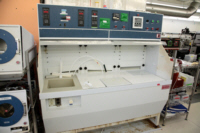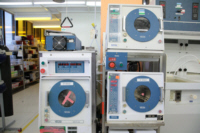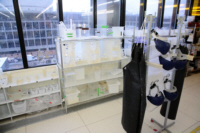Equipment
| Lab and Coral Name | TRL / acid-hood |
| Model | Laminaire |
| Specialist | David Terry (Paul Tierney) |
| Physical Location | 4F Main-South |
Classification
| Process Category | Wet |
| Subcategory | Acids |
| Material Keywords | Silicon, III-V, GaN, Quartz, Pyrex, SiO2, SiNx, Dielectrics, CMOS Metals, Non-CMOS Metals, Non-Standard Materials, 2D Materials, Photoresist, Acids |
| Sample Size | 6" Wafers, 4" Wafers, 7" Photo Plates, 5" Photo Plates, Pieces |
| Alternative | TRL / Greenflo |
| Keywords | multi wafer, manual load, multiple pieces, both sides of sample, isotropic etch, temperature, manual operation |
Description
The acid-hood is a wet station that is used for cleaning and etching purposes with acidic/basic solutions. RED and GREEN processes can be done by using appropriate beakers and aspirators. Sample sizes from pieces to 6” wafer size can be used. Appropriate beakers are required as some chemicals which may not be suitable with glass beakers such as HF. Gown up with apron, face shield, arm protectors and rubber gloves. Thin vinyl gloves and clean room suits do not provide enough protection against corrosive and hazardous chemicals. Get chemicals from the chemical "pass-through" and use the cart to transport them to the acid-hood. Use the small amounts of chemicals left in the bottles by previous users before proceeding to open a new bottle. After done with the process aspirate acids from the beaker in the acid hood. Before de-gowning, clean beakers with DI water and place them at right place. Any kind of solvent is not allowed in acid-hood.
| Best for | Chemical cleaning and etching |
| Limitations | RCA cleans are difficult to perform because this station does not have hotplates built-in. |
| Characteristics/FOM | acid wet bench |
| Caution with | Gown up with apron, face shield, arm protectors and rubber gloves. Do not touch anything in the acid hood area with only vinyl gloves. Be sure about chemical characteristics before planning to use it. Very important to be attentive all the times. |
| Machine Charges | 25/run |
Documents
SOP
| Wet Processing | Rules and guidelines for wet processing |
| Acid hood | How to operate the acid hood and safety rules |
| Chrome masks | How to make chrome masks from transparancies |
| Acid hood rules | Rules and guidelines for the acid hood |
Documents
| Etch rates part 2 | Berkeley etch rate paper |
| Etching of III-V's | An exhautive/ing collection of etch recipes for III-V materials |
Process Matrix Details
Permitted
Been in the ALDSamples that have been in any of the ALD systems
, Pyrex SubstratesPyrex substrates can be a concern due to high sodium content, which contaminates CMOS frontend tools
, III-V SubstratesAny III-V substrates, e.g. GaAs, GaN, InP, and so on. Note though that many common III-V substrates will also carry the Au flag, but there are some GREEN III-V substrates.
, Germanium on surfaceSamples with germanium on the surface (typically grown films)
, Germanium buriedSamples with germanium buried below a different film
, PiecesWafer pieces may not be handled by the equipment, and are harder to thoroughly clean - preventing them from running in certain tools.
, Gold or RED color codeRED color code substrates. These are gold-contaminated or have been processed in gold contaminated tools. Gold and other metals can contaminate silicon devices (GREEN color code) and have to be separated.
, Any exposure to CMOS metalIf the sample had ever seen a CMOS metal (or a tool that accepts CMOS metal), then some frontend tools could be contaminated by this.
, CMOS metal on surfaceCMOS compatible metals exposed on the surface. These are Al,Ni,Pt,Ti,TiN. Other metals such as Au are *NOT* part of this.
, CMOS metal buriedCMOS compatible metals covered entirely by a different material. These are Al,Ni,Pt,Ti,TiN. Other metals such as Au are *NOT* part of this.
, Been in the STS DRIEThe DRIE etch leaves behind polymer residues on the sidewall ripples, which can be a contamination concern for some tools.
, Been in the SEMA sample viewed in the SEM must have used the appropriate chuck to avoid cross-contamination
, Been in the Concept1The Concep1 deposits dielectrics on GREEN wafers, however it also accepts metal and there can be cross-contamination for diffusion area
, Has PhotoresistSamples with photoresist cannot be exposed to high temperatures, which is typical in deposition tools. Outgassing can be a concern.
(Removes), Has PolyimidePolyimide is a very chemically resistant polymer, and can tolerate higher temperatures but cannot be exposed to typical PECVD deposition temperatures or diffusion furnaces. Outgassing can be a concern.
(Removes), Has Cured SU8Not fully cured SU8 residues can heavily contaminated plasma chambers or destroy other user's samples, but fully cured SU8 is permitted in certain tools.
, Coming from KOHAfter a KOH etch, the samples must receive a special clean because the K ions are highly contaminating to CMOS frontend tools
, Coming from CMPAfter a CMP, the samples must receive a special clean, because the slurry residues otherwise introduce contamination and particles.
Not Allowed
Ever been in EMLSamples from EML are never permitted to return to ICL or TRL
For more details or help, please consult PTC matrix, email ptc@mtl.mit.edu, or ask the research specialist (David Terry)


